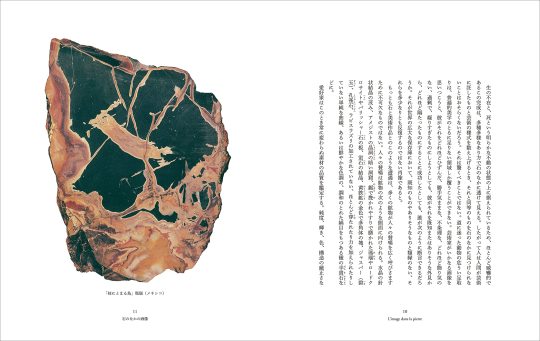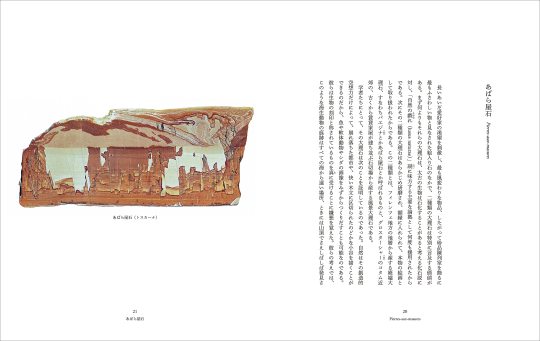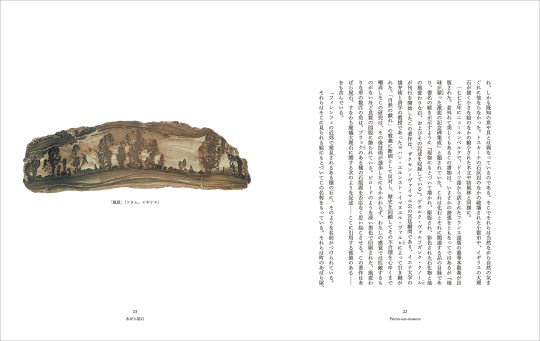#Roger Caillois
Quote
Stones, like us, stand at the intersection of countless lines crossing one another and receding to infinity, at the center of a field of forces too unpredictable to be measured; and we awkwardly call the result chance, hazard, or fate.
Marguerite Yourcenar, from the introduction to The Writing of Stones by Roger Caillois
#quote#Marguerite Yourcenar#Yourcenar#Roger Caillois#Caillois#The Writing of Stones#stones#geology#nature#fate#infinity#infinite#rocks
108 notes
·
View notes
Text
... an extended tattoo, most especially those Japanese tattoos called irezumi which cover almost the entire body of those unstable [...] individuals, the Yakuza. The pride they take in them is proportional to the surface treated, for it is thought to measure the extent of their resistance to pain.
— Roger Caillois, The Dedalus Book of Surrealism: The Identity of Things
8 notes
·
View notes
Photo


Jorge Luis Borges, (1944), Fictions, Translated by Paul Verdevoye and Nestor Ibarra, Foreword by Nestor Ibarra, «La Croix du Sud» 1 [Series directed by Roger Caillois], Gallimard, Paris, 2014, Facsimile reprint of the original 1951 Edition
#graphic design#book#cover#book cover#back cover#jorge luis borges#paul verdevoye#nestor ibarra#roger caillois#gallimard#1940s#1950s#2010s
27 notes
·
View notes
Text
Peu à peu, j'ai été amené à reconnaître dans la croissance de la dissymétrie ce principe complémentaire.
~ Roger Caillois
5 notes
·
View notes
Text

14 notes
·
View notes
Text
A comparable nostalgia persists in a world that no longer grants to the dream this inordinate influence. Everyone continues to experience, as a kind of failure, irritating and sad in turn, that there is nothing more personal than a dream, nothing else so imprisons a person in irremediable solitude, nothing else is as stubbornly resistant to being shared. In the world of reality everything is experienced in common. The dream, on the other hand, is an adventure that only the dreamer himself lived and only he can remember; it is a watertight, impenetrable world that precludes the least cross-checking. Hence the temptation to imagine two or more persons (or even a multitude) having the same dream, or dreams that are equivalent or complementary. The dreams thus corroborate one another, fitting together like the pieces of a puzzle and, by acquiring in this way the solidity and stability possessed by the perceptions of the waking world, they become verifiable like them; even better, they create bonds between the dreamers — rare, secret, narrow, and imperious.
Roger Caillois, Logical & Philosophical Problems of the Dream, from The Dream and Human Societies, 1966.
10 notes
·
View notes
Text

2 notes
·
View notes
Text
"Caillois's definition of play is particularly useful if we apply it to videogames. He argues, first, that play is a 'free' choice; otherwise it loses its nonwork qualities. Second, it is 'separate' from other parts of life, limited in terms of space and time, defined before the activity starts. Third, the outcome is 'uncertain,' meaning the player must take initiative as the results are not fixed beforehand. Fourth, it is 'unproductive,' not creating anything in the process. Fifth, it is 'governed by rules' that create new conventions and ways of doing things while also suspending the regulation of everyday life. Sixth, it is 'make-believe,' meaning it is different to, and set against, real life. When play is defined by these six aspects, it is often structured by games.
We can clearly see each of these qualities with videogames. We make a 'free' choice to play them, usually within the 'separate' environment of the computer or console; we do not know how the play will go in advance, as videogames are 'uncertain' (even if we really good at are the game); the activity is 'unproductive' in the capitalist sense; the videogame contains complex 'rules,' even if many are hidden from the player; and they are 'make-believe' in varying ways. If play encompasses spontaneous and hard-to-capture aspects (what Caillois identifies with the Greek word paidia), then games introduce structured activities with explicit rules (ludus), as well as the elements of competition (agôn), chance (alea), simulation (mimesis), and vertigo (ilinx, referring not to the nausea-inducing physical experience but to the simulation of high speeds or of a reckless rampage). Becoming broadly familiar with each of these qualities will help us make sense of different types of games later.
Caillois was also a surrealist who saw great political potential in avant-garde art. As such, his arguments for politics and games started from the idea that 'for the player to voluntarily be liberated by play/game as a means for a free society, the game has to project a belief system that is beyond a known reality.' In the process, he reproduces part of the magic circle as 'the game has to remain separate from reality.' We can take up these insights from Caillois by reading him through Marx, in which case the concept of play would also begin from a separation, not from reality, but 'from everyday work, separate from the production tools owned not by the worker but by the employer, the capitalist.' The process of play can therefore be a 'means for the worker to cease being a worker, for a limited time, and to become, in a surrealist sense, something else than a slave in the bounds of the capitalist.' This resonates much more with videogame play. Coming home after work to play videogames provides that escape for millions of workers every day. For a moment, each is no longer a worker, but free to explore new worlds outside the drudgery of capitalism.
Videogames provide a space of experimentation, of discovery, but also recovery from capitalist work. In a way, Marshall McLuhan makes a similar claim, arguing that 'art and games enable us to stand aside from the material pressure of routine and convention, observing and questioning. Games as popular art forms offer to all an immediate means of participation in the full life of a society, such as no single role of job can offer to any man.' It is clear that games have historically played important social roles. As McLuhan notes, 'The games of a people reveal a great deal about them.'"
- Jamie Woodcock, from Marx at the Arcade: Consoles, Controllers, and Class Struggle, 2019.
#jamie woodcock#quote#quotations#play#video games#labor#marxism#democratic socialism#class struggle#leisure#anthropology#surrealism#roger caillois#marshall mcluhan#imagination#work#jobs#capitalism
3 notes
·
View notes
Photo

(via TRIGNAC (Gérard) – BORGES (Jorge Luis) - L’Immortel (trad. Roger Caillois). -[...] | lot 125 | Livres Illustrés Modernes chez Ader | Auction.fr)
12 notes
·
View notes
Text
“There is something positive about it. While light space is eliminated by the materiality of objects, darkness is ‘filled’, it touches the individual directly, envelops him, penetrates him, and even passes through him: hence ‘the ego is permeable for darkness while it is not so for light’; the feeling of mystery that one experiences at night would not come from anything else.”
- Roger Caillois, Mimicry and Legendary Pyschasthenia
5 notes
·
View notes
Quote
In some exceptionally large specimens the cracks seem to radiate from two adjacent centers. The wide meshed webs approach one another without overlap ping, explore one another without joining, brush like antennae, like anxious or voluptuous feelers. It is as if the two systems were really conscious organisms trying to get to know one another by cautious touches. They are still only diagrams, closer to the blueprint than to life, but their polarized substance seems to stir. They might be two ameobas about to fight or mate, but because they are frail, perhaps sol ulble, they feel the need to get acquainted first, though they fear the first contact may prove to be corrosive.
Roger Caillois, The Writing of Stones
#quote#stones#The Writing of Stones#Roger Caillois#Caillois#septaria#septarium#geology#nature#organism#ameoba
65 notes
·
View notes
Text









2022年9月3日
【新入荷・新本】
ロジェ・カイヨワ『石が書く』(創元社、2022年)
価格:4,620円(税込)
/////
長らく入手が困難であった名著を新訳で刊行
風景石、瑪瑙、セプタリア(亀甲石)など、特異な模様をもつ石。それらは人の想像力にどう働きかけてきたのか。石の断面の模様と、抽象芸術作品が交わる地点はあるのか。聖なるもの、遊び、神話、詩学、夢といったテーマを縦横に論じてきたカイヨワが、自らの石コレクションをもとに、「石の美は、普遍的な美の存在を示している」と論じた、他に例を見ない論考。1975年に新潮社から翻訳が刊行されながら、長らく日本語では入手困難であった美しい名著を、新たな翻訳で刊行。
ロジェ・カイヨワ
フランスの文学者・批評家。1913年ランスに生まれる。シュルレアリスト・グループとの短い交流ののち、1937年にバタイユらとともに「社会学研究会」を設立。1952年にはユネスコが発行する国際的な学術誌『ディオゲネス』を創刊して編集長となる。『神話と人間』(1938)からはじまる著作のテーマは、神話・聖性・遊び・戦争・幻想芸術・夢など多岐にわたり、「知の巨人」と称される。遠く離れた領域の知を結びつける方法論「対角線の科学」を提唱した。邦訳書に『人間と聖なるもの』『夢の現象学』『遊びと人間』『メドゥーサと仲間たち』『戦争論』『幻想のさなかに』『イメージと人間』『反対称』『蛸』『アルペイオスの流れ』などがある。1978年没。
5 notes
·
View notes
Photo


Jorge Luis Borges, (1944), Fictions, Translated by Paul Verdevoye and Nestor Ibarra, Foreword by Nestor Ibarra, «La Croix du Sud» 1 [Series directed by Roger Caillois], Gallimard, Paris, 1951 [then 2014 Facsimile reprint]
#graphic design#book#cover#book cover#jorge luis borges#paul verdevoye#nestor ibarra#la croix du sud#roger caillois#gallimard#1940s#1950s#2010s
22 notes
·
View notes
Text

via Alexis Orloff
Roger Caillois : Anthologie du fantastique
Soixante récits de terreur, réunis et présentés par Roger Caillois
Le Club Français du Livre - Paris, 1958Maquettes de Jacques Daniel
0 notes
Text
Roger Caillois – İnsan ve Kutsal (2023)
Kutsal ve dünyevi alanların ayrımı insanlığın başlangıcından beri tesis edilmiş gibi görünüyorsa, sosyolog Roger Caillois, arkaik ve gelişmiş toplumlar hakkında cesur bir karşılaştırmalı çalışma yaparak kutsalın anlamını anlamaya çalışan ilk kişiydi.
Çalışmanın en heyecan verici bölümlerinden biri, insan toplumlarının iki önemli döneminde ortaya çıkan kutsallığı analiz ediyor: kutlama ve…

View On WordPress
0 notes
